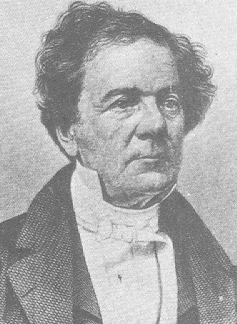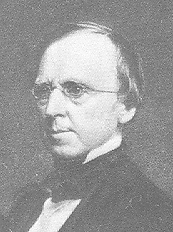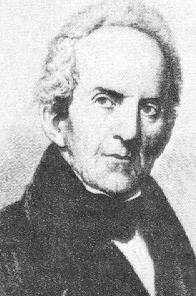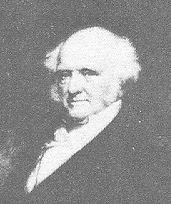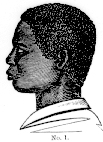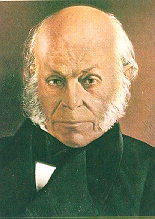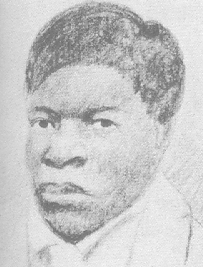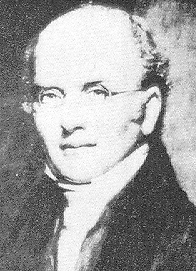
Slaver Montes points at Cinque in mural by Hal Woodruff (Taladega College)
The improbable voyage of the schooner Amistad and the court proceedings and diplomatic maneuverings that resulted from that voyage form one of the most significant stories of the nineteenth century. When Steven Spielberg chose the Amistad case as the subject of his 1997 feature film (LINK TO REVIEWS), he finally brought it the attention the case had long deserved, but never received. The Amistad case energized the fledgling abolitionist movement and intensified conflict over slavery, prompted a former President to go before the Supreme Court and condemn the policies of a present Administration, soured diplomatic relations between the United States and Spain for a generation, and created a wave of interest in sending Christian missionaries to Africa.
Mutiny and Zig-Zagging to American Justice
Two sea captains, Peletiah Fordham and Henry Green, were shooting birds among the dunes at the eastern tip of Long Island on the morning of August 26, 1839, when they were startled to encounter four black men wearing only blankets. Once the blacks were assured through sign language that they were not in slave-holding country, they led Fordham and Green to a point in the dunes where they could see a black schooner, flagless with its sails in tatters, sitting at anchor a mile or so from the beach. Another smaller boat was on the beach, guarded by more black men, many of whom were wearing necklaces and bracelets of gold doubloons. One of the black men, who appeared to be the leader of the group, told Fordham and Green that there were two trunks full of gold aboard the schooner, and that they would be given to whoever outfitted them with provisions and helped them sail back to their African homeland. Green suggested that if they got the trunks he would help them return to Africa.
Green's and Fordham's dreams of riches were interrupted by a brig of the U. S. Coast Guard, the Washington, which intercepted the rowboat as it made its way back to the schooner. The commander of the brig, Lieutenant Thomas Gedney, boarded the schooner and ordered, at gunpoint, all hands below the deck. Two Spaniards emerged from below. One was old, bearded, and sobbing. The other was a man in his mid-twenties. Jose Ruiz, the younger man, spoke English and eagerly began to tell the tale of mutiny, blood, deceit, and desperation aboard the Amistad.
The schooner had left Havana on June 28, bound for Puerto Principe, a Cuban coastal town. Aboard the Amistad were five whites, a mulatto cook, a black cabin boy, and fifty-three slaves. Ruiz had bought forty-nine adult male slaves at the Havana market. The older, bearded white, Pedro Montes, had bought four child slaves, including three girls. On the fourth night at sea, the slaves managed to free themselves from their irons. In the ensuing struggle, one of the Africans, Cinque, killed the mulatto cook with a sugar cane knife. (According to the story later told by the Africans, the mulatto cook had told the slaves that they would be chopped to pieces and salted as meat for the Spaniards when the ship arrived at its destination.) He used the same knife to wound the ship's captain, Ramon Ferrer, then other slaves finished the job by straggling him. Two crewman abandoned ship in the stern boat.
Montes and Ruiz were spared, apparently because their help was thought necessary in steering the ship to Africa. Montes sailed toward Africa, but slowly and only during the day. At night, he reversed course and headed due west, hoping to landfall in the southern United States. After six weeks of zig-zagging at sea, the Amistad arrived in New York.
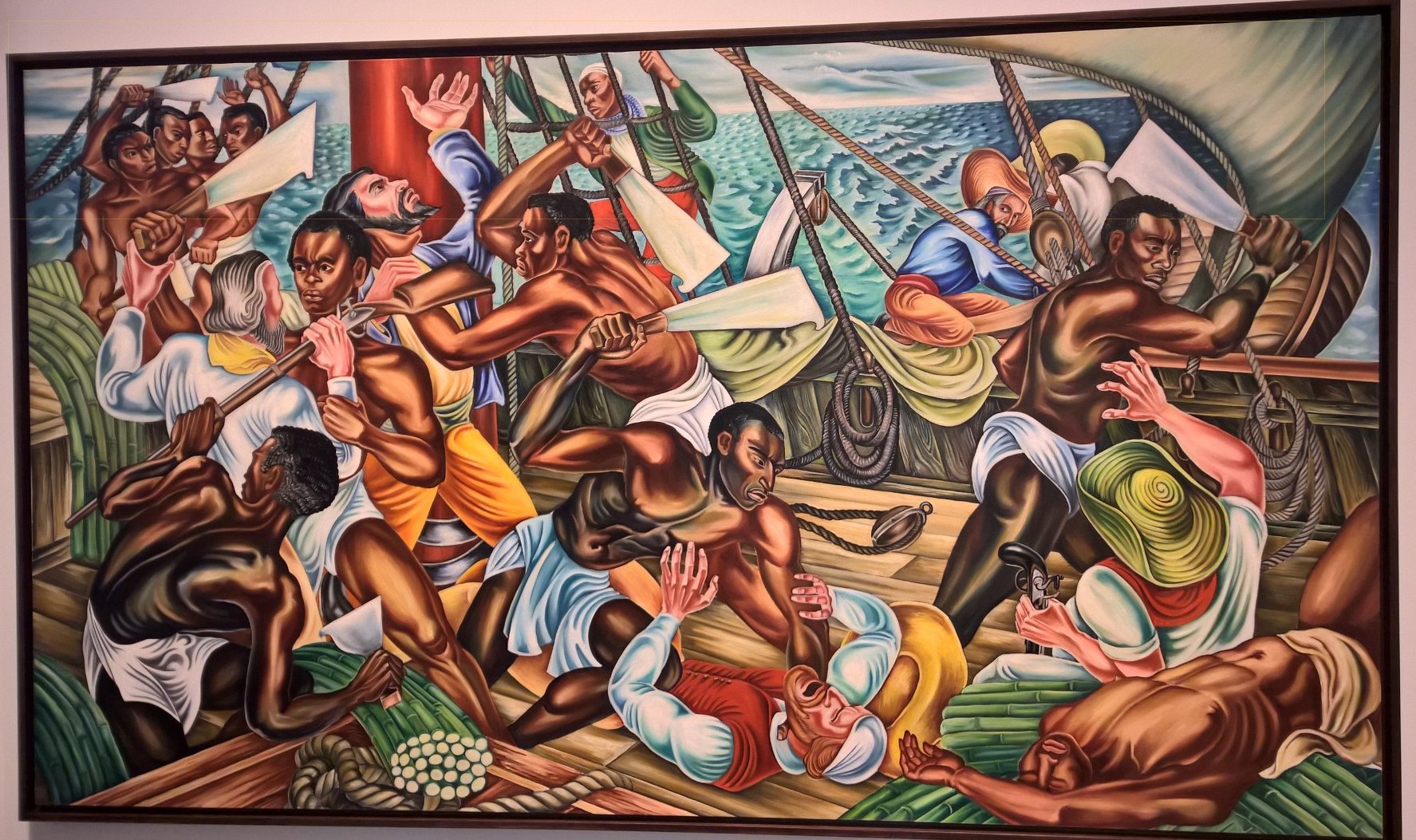
The Mutiny: Hal Woodruff mural
(What Ruiz did not say was that the slaves were were recently brought from Africa and brought to Cuba in direct contravention of an 1817 treaty between Spain and Britain prohibiting the importation of slaves to Spanish colonies. Using falsified passports, corrupt officials, and nighttime landings, slave traders often were successful in eluding the British ships that patrolled waters in an effort to enforce the importation ban.)
As Ruiz told his story, an athletic-looking black man, naked except for a gold necklace, suddenly appeared from below and leaped off the boat. The Washington gave chase, but the man was a strong swimmer, constantly diving as the ship neared. Tiring, the man took off his necklace, letting it--to the dismay of Gedney--fall to the bottom of the sea. Finally, crew members recaptured the black man, later known as Cinque, and put him into chains. The Amistad was towed to New London, Connecticut, where its arrival would dominate the news for weeks to come. Why tow the schooner to Connecticut, rather than a much closer port in New York? Most likely, Gedney knew that slavery was illegal in New York in 1839, but not in Connecticut. Gedney and the crew of the Washington intended to seek salvage--that is, a percentage of the value of the cargo, including the value the Africans would have as slaves--and his prospects might be better in Connecticut. The Amistad's cargo of wine, saddles, gold, and silk was worth an estimated $40,000 in 1839 dollars, and the slaves had a market value of at least half that much.
The United States Attorney for Connecticut, William S. Holabird, ordered a judicial hearing on the Washington. It was unclear to Holabird, as it was to many, whether a crime had been committed, who had committed it, or whether U.S. courts even had jurisdiction. There was also the matter of salvage rights, claimed by Gedney.
One the day criminal charges were filed against the Africans, a delighted Pedro Montes was interviewed by a reporter. The reporter wrote, "Montes sat smoking his Havana on the deck of the ship with a martyr-like serenity." Meanwhile, the other slave owner, Jose Ruiz, predicted to reporters that all the slaves would be sent back to Cuba. He expected the ringleaders to be executed, and the rest given back to him.
The district judge for Connecticut was Andrew T. Judson, an appointee of President Andrew Jackson. Judson was not likely to sympathize with the Africans, having six years earlier prosecuted a Connecticut schoolmistress for establishing a school for Negroes that Judson claimed violated a state law against encouraging black migration. (When the jury was unable to reach a verdict in the case, a mob set fire to the schoolmistress's house.)
The Criminal Trial
On August 29, 1839, three days after the schooner's discovery, Judge Judson opened a hearing on complaints of murder and piracy filed by Montes and Ruiz. Thirty-nine Africans (of the forty-three who had survived the weeks at sea) were present, including Cinque, who appeared wearing a red flannel shirt, white duck pants, and manacles. He appeared calm and mute, occasionally making a motion with his hand to his throat to suggest a hanging. This hearing, to be clear, was not a trial. Its purpose was to determine if there was a basis for going forward with a criminal trial None of the three witnesses who testified sympathized with the Africans.
The principal witnesses at the hearing were the first mate of the Washington and Montes and Ruiz. The first mate described what happened when the Amistad was first boarded. Montes and Ruiz described the mutiny and subsequent weeks at sea. Ruiz testified:
"I took an oar and tried to quell the mutiny. I cried 'No! No!.' I then heard one of the crew cry murder. I then heard the captain order the cabin boy to go below and get some bread to throw among the negroes, hoping to pacify them. I did not see the captain killed."
Montes added his description of events on the fourth night at sea:
"Between three and four was awakened by a noise which was caused by blows to the mulatto cook. I went on deck and they attacked me. I seized a stick and a knife with a view to defend myself....At this time [Cinque] wounded me on the head severely with one of the sugar knives, also on the arm. I then ran below and stowed myself between two barrels, wrapped up in a sail. [Cinque] rushed after me and attempted to kill me, but was prevented by the interference of another man....I was then taken on deck and tied to the hand of Ruiz."
After listening to the testimony, Judge Judson referred the case for trial in Circuit Court, where in 1839 all federal criminal trials were held, and ordered the Africans put into custody at the county jail in New Haven. The Amistads became a huge attraction. As many as 5,000 people a day visited the jail. The jailer charged "one New York shilling" (about twelve cents) for close looks at the captives. The Africans also attracted scientific interest. A phrenologist examined the captives and took "life masks" which were later put on public display. The New Haven jail was relatively loose. Jailers took the children, "robust" and "full of hilarity," on wagon rides. The adults were allowed daily exercise on New Haven's green, where their cavorting, somersaults, and acrobatic leaps surprised residents unaccustomed to such public displays of exuberance.
Lewis Tappan
For most New Englanders the Amistads were a curiosity. For a small, but growing, group of abolitionists, however, they were a cause and an opportunity. Abolitionist leader Lewis Tappan described the capture of the Africans as a "providential occurrence" that might allow "the heart of the nation" to be touched "through the power of sympathy." The abolitionist publication The Emanicipator declared that "God ordered" the Amistad to our shores to "hasten the overthrow of slavery." Here was a chance to expose the inhumanity of slavery--and abolitionists meant to take advantage of it. The "Amistad Committee" was quickly formed and soon the group had enlisted legal help, including that of Roger Baldwin, who would later become the governor of Connecticut.
But Baldwin faced a problem. The Africans understood scarcely a word of English. And Baldwin knew not a word of Mende, the language of most of the Africans--and a language now spoken in the nation of Sierra Leone. But New Haven, conveniently, was the home of Yale. Baldwin found a professor of linquistics and an African interpreter to help with communication with his clients. Through his interpreters, Baldwin discovered that the Africans actually came from six different tribes and spoke several different languages. They had only been in Cuba a short time before their sale in a Havana slave market. The fact that the slaves had recently come from Africa, and were not longtime Cuban slaves, would be critical to the defense case.
Spain, meanwhile, pressed the United States to return the schooner to its Cuban owners, concede that the U. S. courts had no jurisdiction over Spanish subjects, and return the Amistads to Havana. The Van Buren Administration was anxious to comply with the Spanish demands, but there was this matter of due process of law. The Administration, through District Attorney Holabird, crafted legal arguments that it hoped would produce the results sought by Spain.
Roger Baldwin
On September 14, 1839, the Amistads were sent by canal boat and stage to Hartford for their trial in the Circuit courtroom of Judge Smith Thompson, who also served (as was then the custom for Circuit Court judges) as a justice on the United States Supreme Court. Holabird asked the court to turn all the prisoners over to the President and to let him decide this matter that bore heavily on the relations between great powers. Baldwin, for the defense, argued that "no power on earth has the right to reduce [the Africans] to slavery" and the United States should never stoop so low as to become a "slave-catcher for foreign slave-holders." Judge Thompson preferred to evade the larger debate over abolition and rested his decision on jurisdictional grounds. He decided after three days of argument that because the alleged mutiny and murders occurred in international waters and did not involve U.S. citizens, the court had no jurisdiction to consider the criminal charges.
Judge Smith Thompson
Were the slaves "property"? That was a matter, Judge Thompson ruled, that had to be decided first in the district court. Thompson ruled that the Africans, although no longer considered prisoners, should be detained until the district court could decide whether they were property and--if they were property--who owned them.
The Civil Trial: Were the Amistads Property?
The defense devoted considerable time to the task of trying to locate someone familiar with the language spoken by the Africans. Dr. Josiah Gibbs, a Yale philologist, and a clergymen who trained the deaf and dumb examined the Africans. They concluded that the Amistads were Mende, from a region south of Freetown in what is now Sierra Leone. Gibbs learned to count in Mende, then wandered up and down the waterfronts of New York counting in Mende, looking for signs of recognition among the Africans he encountered. Finally his efforts were successful, and a Mende speaker, James Covey, was brought to New Haven.
The full story of the Africans' adventures began to come out. The Amistad captives had first met at a slave factory in Lomboko after having been kidnapped by African slavers. They along with several hundred other Africans were loaded aboard the Portugeese ship Tecora and taken via the infamous two-month "Middle Passage" across the Atlantic. The slaves were kept naked, flogged for not eating, and chained in a half-lying position. Many died at sea and were tossed overboard. Landing at night in Havana, they were taken to the "barracoon," or slave market where ten days later they were bought by Ruiz and Montes. On the fourth night of the Amistad's voyage, Cinque used a nail to break the chain that fastened all the slaves to the wall, and the mutiny began.
Life in Connecticut for the Amistads began to take on a semblance of normalcy. For two to five hours a day they were instructed in English and theology by students of the Yale Divinity School. Bonds between some of the Africans and their teachers began to develop. Still, it was a trying time for many of the Amistads, experiencing their first harsh weather, exposed to new diseases, and the length of their separation from their homeland growing with no end in sight. Tu-a became the first African to die in New Haven, occasioning a raucous funeral that raised many New Englanders' eyebrows.
The Amistad civil trial began on November 19, 1839 in Hartford. After two days of testimony, the trial was adjourned until January 7, 1840. In the New Haven harbor was the naval schooner Grampus, sent there by President Van Buren to sail the Amistads back to Cuba should the court rule, as expected, in the government's favor. Van Buren's secret orders provided that the Africans were to be rushed immediately to the ship and placed in irons before an appeal could be filed, and that the Grampus should sail for Havana unless an "appeal shall actually have been interposed."
President Martin Van Buren
Baldwin and the Amistads' lawyers produced several witnesses to support their claim that the Africans were illegally imported from Africa and were therefore the property of no one. Dr. Gibbs, as a linguistics expert, testified that most of the Amistads spoke Mende, not Spanish. Cinque and Grabeau, another of the Africans, recounted (through James Covey, their interpreter) the story of their capture, voyage across the Atlantic, sale in Havana, mutiny, and eventual arrival in Long Island. Spectators reportedly listened to Cinque "with breathless attention." The New Haven Herald reported that he "manifested a high degree of sagacity, of keenness, and decision." Sullivan Haley testified that Ruiz, now back in Cuba, had admitted that the captives were not legal slaves. Francis Bacon, a local resident who had visited the west African coast in the summer of 1839 described how Lomboko was frequented by Cuban traders and how the slave trade was "the universal business of the country." (The slave factory at Lomboko, incidentally, had been raided by the British one month before the trial, and all slaves held there had been liberated.) Baldwin also introduced the deposition of Dr. Richard Madden, an abolitionist and the British anti-slavery commissioner in Cuba. He described how Cuban authorities "winked at the slave trade in return for $10 to $15 a slave," used fraudulent documents to deceive inspectors, and would without hesitation kill the Amistad blacks should they be returned to Cuba. (LINK TO MADDEN DEPOSITION) (After giving his deposition, Madden returned to London where, in an audience with Queen Victoria, he explained the facts surrounding the Amistad Affair.)
Sketch of Cinque (or Cin-gue)
District Attorney Holabird introduced statements from the Spanish consul urging that the Amistads be returned to Spain and presented testimony and depositions of crew members of the Washington describing their discovery and capture of the Amistad , while Gedney's counsel tried to establish that Cinque was himself a slave trader.
Judge Judson announced his decision on January 13, 1840, after a weekend of deliberation. He ruled that the Amistad captives were "born free" and kidnapped in violation of international law. They had mutinied, he said, out of a "desire of winning their liberty and of returning to their families and kindred." He ordered that the Amistads be "delivered to President Van Buren for transport back to Africa." He ended his opinion with the observation, "Cinque and Grabeau shall not sigh for Africa in vain. Bloody as may be their hands, they shall yet embrace their kindred." The Grampus sailed out of New Haven harbor without its black passengers. Van Buren was described as "greatly dissatisfied."
The Administration's Appeal to the Supreme Court
The Administration appealed Judson's decision, but it was affirmed by Circuit Judge Thompson. The Administration again appealed, this time to the United States Supreme Court, where five of the nine justices were southerners who either owned or had owned slaves.
After an appeal was made to the Supreme Court, Lewis Tappan visited John Quincy Adams at his home in Massachusetts in an effort to persuade "Old Man Eloquent" to argue the Africans case in Washington. Former President Adams, then 74 and a member of Congress, at first resisted, pleading age and infirmity. But Adams believed firmly in the rightness of the cause, and eventually agreed to join Baldwin in arguments before the Court. "By the blessing of God, I will argue the case before the Supreme Court," Adams was quoted as saying. That October, 1840 date he wrote in his diary: "I implore the mercy of God to control my temper, to enlighten my soul, and to give me utterance, that I may prove myself in every respect equal to the task."
John Quincy Adams
The next month Adams stopped by Westville, near New Haven, to visit his clients. He found them all in a thirty-foot-by-twenty-foot room, taken up almost entirely by thirty-six cots. Adams shook hands with Cinque and Grabeau, telling them "God willing, we will make you free." Later, Adams would receive touching letters from two of the younger Africans, Ka-le and Kin-na.
Kinna
On Monday, February 22, 1841, arguments began in the Supreme Court's crowded chamber in the U.S. Capitol. (Among those in attendance was Francis Scott Key, author of the "Star Spangled Banner" and now an attorney, who approached Adams and offered his advice on the case.) Attorney General Henry Gilpin, arguing for the government, told the Court that it should not "go behind" the Amistad's papers and make inquiry as to their accuracy, but should accept them on their face in order to show proper respect for another sovereign nation.
Roger Baldwin followed Gipin, making many of the same arguments that been persuasive in the district and circuit courts. (LINK TO BALDWIN ARGUMENT). Baldwin told the justices that the Court can and should look to see if the Cuban paperwork is fraudulent. And, if the Court finds fraud, then treaties should govern. The Africans should be declared free--free to go home to Africa if they choose, free to stay in the United States if they choose. It was the same argument that had persuaded the lower courts.
John Quincy Adams began his argument on February 24th. He did not disappoint. Justice Story later called Adams's argument "extraordinary for its power, for its bitter sarcasm, anf for its dealing with topics far beyond the record and points of discussion." It was at times eloquent. It was at times a harangue. And it times it resembled a lecture on political science.
Adams argued that if the President had the power to send the Africans to Cuba, he would equally as well have the power to seize forty Americans and send them overseas for trial. He argued that Spain was asking the President to "first turn man-robber,...next turn jailer,... and lastly turn catchpole and convey them to Havana, to appease the vengeance of the African slave-traders of the barracoons." He attacked the President for his ordering a naval vessel to stand ready in New Haven harbor. He asked, "Was ever such a scene of trickery enacted by rulers of a great, magnanimous and Christian nation?" He attacked a southern intellectual's defense of slavery, and he quoted the Declaration of Independence: "The moment you come to the Declaration of Independence, that every man has a right to life and liberty, an inalienable right, this case is decided. I ask nothing more in behalf of these unfortunate men than this Declaration."
Adams ended his Supreme Court argument on a personal, reflective note:
"May it please your Honors: On the 7th of February, 1804, now more than thirty-seven years past, my name was entered, and yet stands recorded, on both the rolls, as one of the Attorneys and Counselors of this Court. Five years later, in February and March, 1809, I appeared for the last time before this Court, in defense of the cause of justice, and of important rights, in which many of my fellow-citizens had property to a large amount at stake. Very shortly afterwards, I was called to the discharge of other duties--first in distant lands, and in later years, within our own country, but in different departments of her Government. Little did I imagine that I should ever again be required to claim the right of appearing in the capacity of an office of this Court; yet such has been the dictate of my destiny--and I appear again to plead the cause of justice and now of liberty and life, in behalf of many of my fellow men, before the same Court, which in a former age, I had addressed in support of rights of property. I stand again, I trust for the last time, before the same Court--hic caestus, artemque repono. I stand before the same Court, but not before the same judges--nor aided by the same associates--nor resisted by the same opponents. As I cast my eyes along those seats of honor and of public trust, now occupied you, they seek in vain for one of those honored and honorable persons whose indulgence listened then to my voice. Marshall--Cushing--Chase--Washington--Johnson--Livingston--Todd-- Where are they? . . . Where is the marshal--where are the criers of the Court? Alas! where is one of the very judges of the Court, arbiters of life and death, before whom I commenced this anxious argument, even now prematurely closed? Where are they all? Gone! Gone! All gone!-- Gone from the services which, in their day and generation, they faithfully rendered to their country. . . . In taking, then, my final leave of this Bar, and of this Honorable Court, I can only ejaculate a fervent petition to Heaven, that every member of it may go to his final account with as little of earthly frailty to answer for as those illustrious dead, and that you may, every one, after the close of a long and virtuous career in this world, be received at the portals of the next with the approving sentence, ‘Well done, good and faithful servant; enter thou into the joy of they Lord.'"
Justice Joseph Story
On March 9, 1841, the Supreme Court announced its decision. Justice Story, speaking for the Court, said that the Amistads were "kidnapped Africans, who by the laws of Spain itself were entitled to their freedom." As justification for the Court's decision, Justice Story relied largely on the narrower arguments of Roger Baldwin, rather than the "interesting remarks" of John Quincy Adams. (LINK TO SCT DECISION) The Africans were free: they could stay or they could return to Africa. (The decision was, of course, by no means a repudiation of slavery, and clearly implied that if the Amistads had been brought from Africa prior to the 1820 treaty banning importation of slaves, they would have been considered property of Ruiz and Montes and been returned to Cuba.)
Reactions to the decision varied. Adams wrote that he was filled with "great joy." The Amistads were described as "ecstatic." Lewis Tappan and other evangelical abolitionists saw an opportunity for the Amistads to become the key to an effort to bring Christianity to black Africa. The Spanish government angered and somewhat mystified by the Court's action, began a long series of unsuccessful diplomatic efforts to obtain indemnification for loss of the Amistad and her cargo.
Epilogue
Most abolitionists hoped the Africans would choose to stay in the United States, where they could continue to remind people of the evil of slavery. Lewis Tappan moved the Africans to Farmington, Connecticut. There, for the next eight months, they received about six hours per day of instruction, tended a garden of corn, potatoes, beets, and onions. In addition, they travelled as a sort of pro-abolition vaudeville team around New England, holding church "meetings" in which the Africans would describe their homes and their kidnapping, sing native songs, and read from the Bible. Cinque quickly developed a reputation as a powerful orator.
Efforts began to raise the money necessary to transport the Amistads back to their Mende homeland. Some local residents complained when the need for money caused some of the Africans to begin to charge for jumping, talking, and singing. Cinque asked $3 for a song. The Amistads, strangers in a strange land, were not without their problems. One of the Amistads, Fon-ne, drowned in a pond, an apparent suicide. Grabeau was the victim of an assault. Others were the victims of racial taunts. Cinque was involved in a brawl with some local rowdies. It was, everyone recognized, time to go. Tappan redoubled efforts to recruit missionaries to accompany the Africans back to Sierra Leone.
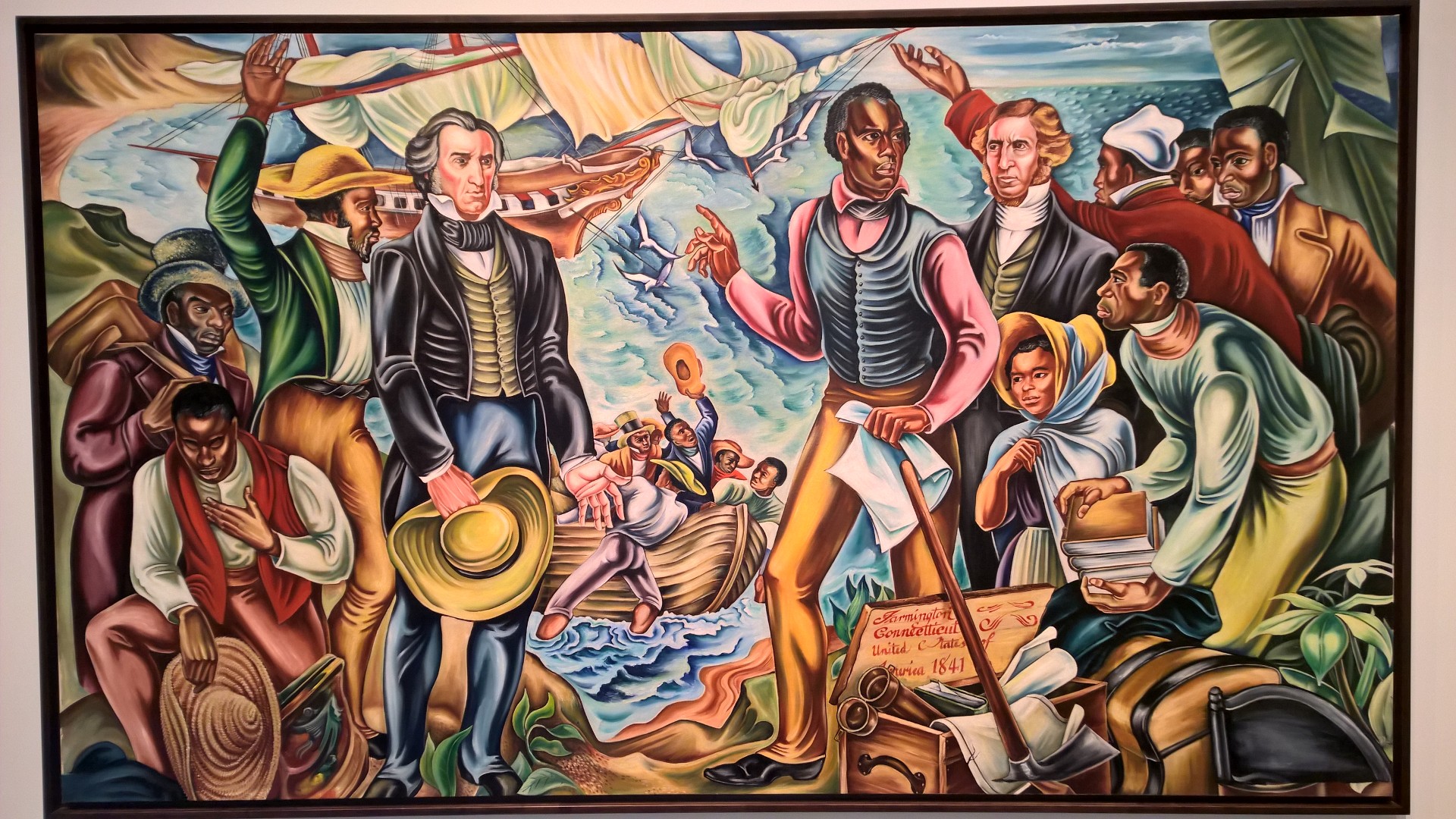
"Return to Mendeland" (Hale Woodruff mural)
In November, 1841, the ship Gentleman was chartered for $1840 to carry the Africans back to Freetown, where the Governor of Sierra Leone said the group would be met and guided on a four-day journey to Mendeland.
On December 4, Lewis Tappan, a handful of other abolitionists, and the Africans gathered on a steamboat that would take them to the larger ship that was anchored off Statan island. After a moving and tearful round of goodbyes, and the offering of a gift to each the Africans, the thirty-five survivors of the Amistad and four American missionaries boarded the Gentleman, bound for West Africa. (Only one African, Sarah, would ever return to America. She attended Oberlin College and then spent the rest of her life working at the mission in Africa.)
A few months later, Tappan received his first communication from the Africans. It was a letter, composed at sea near Sierra Leone, from Cinque. Cinque wrote, "Cinque love Mr. Tappan very much, and all Mendi people love Mr. Tappan very much. I no forget Mr. Tappan forever and ever, and I no forget God, because God help Mr. Tappan and Mendi people. . . .I thank all American people for they send Mendi people home. . . Your friend, Cinque."
After fifty days at sea, the Gentleman put down anchor in Freetown harbor. It didn't take long for the missionaries to realize they had their work cut out for them. After disembarking, some of the Africans began to strip and engage in "heathenish dancing." British missionaries in Freetown told the Americans that their plan to establish a mission in Mendeland was folly. Soon the missionaries wrote letters complaining of their Amistad students: some fell back to their "licentious habits," some disappeared, some were just trouble. Others, such as Kin-na, were clearly torn by the pull of two different worlds, becoming an ordained minister but practicing polygamy. The missionaries also contended with rats (Brother Raymond killed 164 in a single day), the 175 annual inches of rain, malaria and yellow fever ("black vomit.") One by one, the missionaries died and were replaced by others. With the new arrivals, the character of the mission might also change. Tolerance might turn to hell-fire and ex-communication.
The last of the Amistad Africans to have contact with the mission was Cinque. In 1879, old and emaciated, he stumbled into the mission to die and was buried among the graves of the American missionaries.
Although every American President from the time of the Amistad decision of the Supreme Court until 1860 urged that Spain be compensated, efforts to appropriate funds for such a purpose were consistently stymied in the House. John Quincy Adams led the opposition to compensation efforts until his death in 1847, calling the proposal "a robbery of the people of the United States." With the election of Abraham Lincoln in 1860, Spain's efforts came to an end.
For a more detailed essay on the Amistad case, see:
Stamped With Glory: Lewis Tappan and the Amistad Trials

